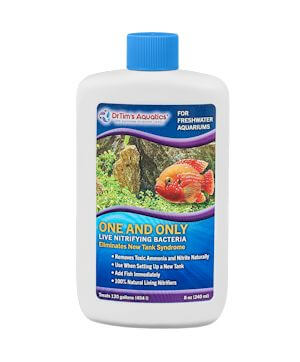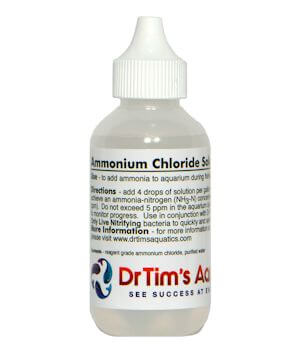Quick Guide to Fishless Cycling with One & Only
There are many opinions about how to fishless cycle your aquarium. But they normally just confuse readers and generate more questions than answers. Below is an article explaining the process and a couple of ways to fishless cycle, which we encourage everyone to read. Need more information about Fishless Cycling? You can find it in the article: DrTim’s Guide to Fishless Cycling
Here we present a short, concise recipe on how to fishless cycle your aquarium. You can choose to add DrTim’s One & Only Live Nitrifying Bacteria or not with this method. But, of course, by adding our bacteria, the cycling time will be shorter and you’ll be watching fish in your aquarium sooner.
MATERIALS NEEDED:
You will need an ammonia solution, ammonia and nitrite test kits (a pH test kit is also a good idea) and a little patience.
The Process:
- Day 1 – dose ammonia to 2 ppm ammonia-nitrogen [NH3-N] using our ammonium chloride (1 drop per gallon [After Nov 2016 when using DrTim’s ammonium chloride use 4 drops per gallon]) [NOTE: do not expect your test kit to exactly read 2 ppm and it is not critical to get exactly 2 ppm. The key is to not add too much ammonia]. If using DrTim’s Aquatics One & Only Live Nitrifying bacteria add it now (turn skimmer, UV and ozone off and remove filter socks for 48 hours).
- Day 2 – Measure ammonia and nitrite.
- Day 3 – If ammonia and nitrite are below 1 ppm add more ammonia: four drops of our ammonium chloride per gallon (check the label).
- Days 4 & 5 – Measure ammonia and nitrite.
- Day 6 – If ammonia and nitrite are below 1 ppm add 2 ppm ammonia. Four drops of our ammonium chloride per gallon. [NOTE: since you have added the One & Only your ammonia kit will not read 2 ppm and DO NOT continue adding ammonia trying to get to 2 ppm – just add 2 ppm ammonia (4 drops per gallon of our ammonium chloride) and carry-on.
- Days 7 & 8 – Measure ammonia and nitrite. On the first measurement day (Day 2, 4, 5, 7 or 8) that BOTH ammonia and nitrite are both below 0.5 ppm (NH3-N or NO2-N) your tank is close to being cycled.
- Now start to measure ammonia and nitrite every day.
- When BOTH ammonia and nitrite are below 0.2 ppm (NH3-N or NO2-N), add another 2 ppm ammonia.
- Continue to measure every day. When you can add 2 ppm ammonia and BOTH ammonia and nitrite are below 0.2 ppm (NH3-N or NO2-N) the next day your tank is cycled – congrats! You’re done!
- Do a partial water change and add some fish.
Tips and Troubleshooting:
- IMPORTANT – Do not let the ammonia OR nitrite concentration get above 5 ppm.
- NOTE – As of November 2016 DrTim’s changed their ammonium chloride solution and you use 4 drops per gallon instead of 1 drop per gallon. Read the label on the bottle you have and follow the directions on the bottle.
- If either ammonia or nitrite concentration get above 5 ppm, do water changes to lower the concentration.
- Do not let the pH drop below 7. If it does, do a partial water change to bring the pH back up.
- Do not add ammonia removers to bind the ammonia – overdosing with these products will just increase the cycling time.
- You do not have to add ammonia everyday – the bacteria do not have to be fed every day. Adding ammonia everyday will results in a sky-high nitrite reading and slow the cycling process.
- Is your tank bare-bottom? – if your tank does not have substrate (gravel or crushed coral) on the bottom this is called a bare-bottom tank and they take longer to cycle because there is not very much substrate for the bacteria to adhere to. If you are setting-up a quarantine tank and do not want to use a traditional substrate consider adding some inert glass rock or marbles or some other non-calcium-based media to the tank bottom. This will help cycle the tank faster.
Need more information about Fishless Cycling? You can find it in the Guide below and you can also download a day by day, step by step Recipe:




 Yes, there really is a Dr. Tim. It all started with 2 goldfish won at a school fair at age 6 that didn’t survive their first night in his care. DrTim’s gotten better at fish keeping since then! Read Our Story.
Yes, there really is a Dr. Tim. It all started with 2 goldfish won at a school fair at age 6 that didn’t survive their first night in his care. DrTim’s gotten better at fish keeping since then! Read Our Story.